- High Field Gradient RF System for J-PARC and Upgrade -
We, KEK, cooperate with the Japan Atomic Energy Agency (JAEA) and developed a high field gradient RF system for a proton accelerator. This system is now under operation for J-PARC. The acceleration system is the “heart” of an accelerator and it is quite important because it determines the performance of the accelerator. A newly developed accelerating system using a Magnetic Alloy enables three improvements which are not available by older type systems. These are a higher field gradient than that of classic ones, mixing of multi-harmonic RF and high accuracy of the system below a few nano-seconds. We are also developing the system further by improving the magnetic material. This way, we expect to increase the beam intensity and improve the performance of the accelerator complex.
 |
||
<Figure 1> Magnetic Alloy-loaded cavities for J-PARC RCS. |
<Figure 2> Magnetic Alloy-loaded cavities for MR |
High Field Gradient Cavity
One of the big differences between proton and electron synchrotrons is the variation of the accelerating frequency. In the electron synchrotrons, the electron beams are accelerated with a fixed-frequency RF system. However, it is necessary to change the RF frequency in most of the proton synchrotrons because the proton is much heavier than the electron. Except for very high energy proton rings, magnetic materials were loaded in the cavities and the accelerating frequency was swept in parallel to the variation of permeability. So far, ferrite materials were used in many accelerators. In J-PARC RCS, the RF frequency at the harmonic (H=2) is varied from 940 kHz to 1.67 MHz.
There were three problems related to ferrite cavity use for J-PARC. They are: saturation already with low RF field, narrow band width and sensitivity on temperature and environmental conditions. The first problem is severe when we build an accelerator in a limited space (see <Fig. 3>). To solve the problem, we have developed a Magnetic Alloy (nano-crystalline alloy and amorphous)-loaded cavity. As nano-crystalline alloy has a ten times higher saturated magnetic flux density than ferrite materials, it can be employed to generate a high field gradient. In J-PARC, large-size ring cores are wound with alloy tape and epoxy-coated to use the water-proof cores in de-mineralized water for good cooling performance (see <Fig. 4>). Using the high-field gradient cavity, the necessary length for RF acceleration was reduced and the compact accelerator was become possible.
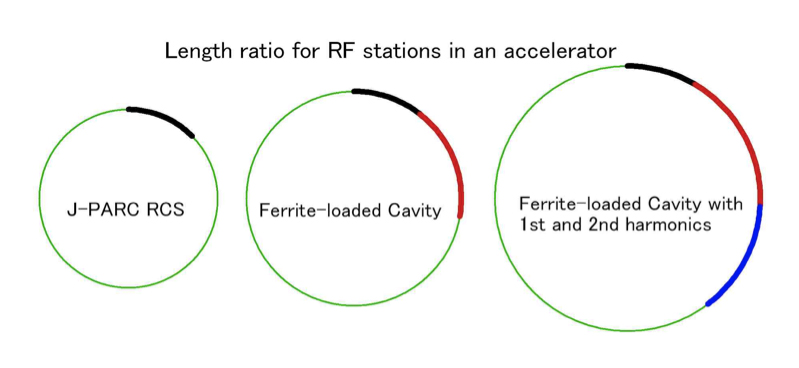
<Figure 3> Field gradient and ratio of space occupied by RF systems in accelerators. As J-PARC achieved a high field gradient, the ratio is only 12 % (Black line in left figure). Green lines mean other components, magnets, injection, extraction and collimation. If ferrite-loaded cavities were used, a longer length would be necessary (Red line in middle figure). If the 2nd harmonics which is used in the present J-PARC RCS is required, another length increase the circumference becomes necessary (Blue line in right figure).
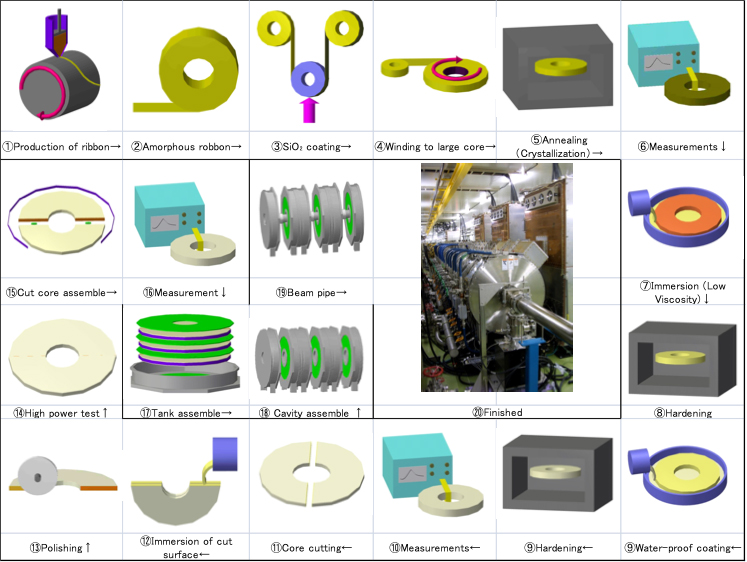 |
<Figure 4> Production process of RF cavity for MR. The cores and cavity are produced after many processes. In case of RCS cavity, processes ⑦、⑧、⑪〜⑯ are skipped. |
Mixing of the 2nd harmonic RF
To handle the “Space Charge Force” which is a repulsive force of particles with same charge is the key issue to improve the performance of a high intensity proton accelerator. The effects are large around the injection in which the velocity of particles is slow and it causes the beam loss. To reduce the loss, the charge density should be reduced. However, the aperture of the beam pipe is limited and it is not very easy to enlarge the beam size. Therefore, it is effective to lengthen the beam bunches. The second harmonic RF, which is twice of the acceleration frequency, is required then. Adding the 2nd harmonics RF to the acceleration voltage, the area where the particles can oscillate will be extended and the charge density can be reduced (see <Fig. 5>). The cavity which is used in J-PARC RCS can operate at same time with both harmonics added together. The RCS has already achieved 300 kW-operation and is further increasing the beam power. This 2nd harmonic RF is a key technology to accelerate the high intensity beam with only a moderate beam loss (see <Fig. 6>).
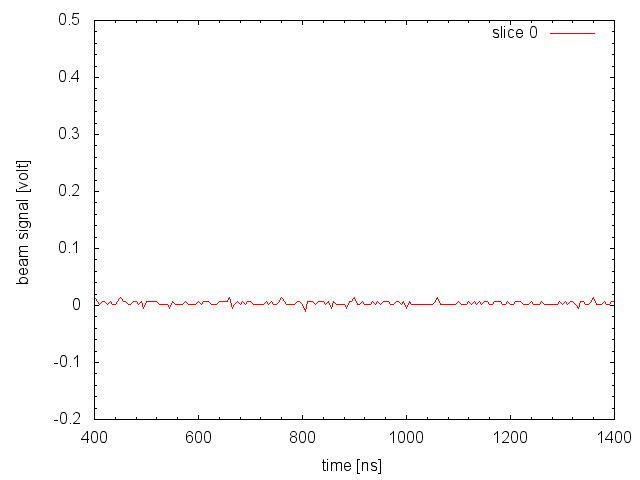 |
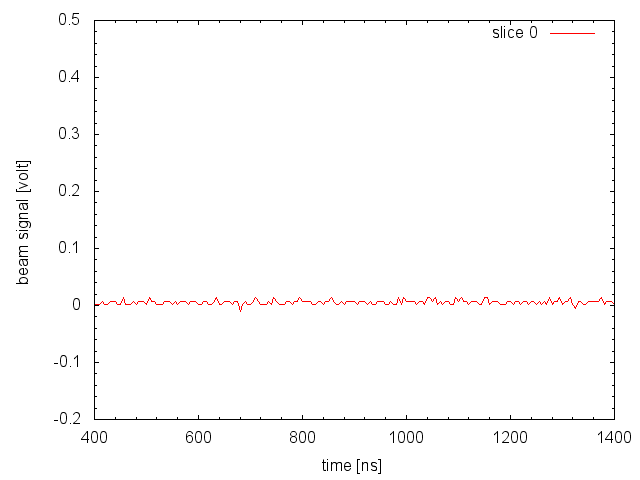 |
<Figure 5> Beam bunch shapes. Left: peak current becomes high during injection when the 2nd harmonic RF is not applied. Right: Peak current is reduced when it is applied. The bunch length is extended. |
|

<Figure 6> The variation of beam current during acceleration (0.02 sec.) in case of the 300kW operation. Red and light blue lines mean the ration when the 2nd harmonic RF was not applied. The beam loss occurred at the beginning. Other colors (green, blue and violet) mean the ratio when it is applied. By adding it, the space charge force was reduced and the beam loss was decreased.
Further Improvements on Higher Field Gradient and High Performance
Developments to increase the field-gradient of the cavity are progressing. We aim to increase the cavity shunt impedance by improving the production process of the nano-crystalline alloy. A test production system to anneal a magnetic alloy core with a large size for accelerator use is under construction in the Hadron Hall in J-PARC with a cooperation in Hitachi metal Co. who is making the present cores. Research using a μSR technique is undergoing in MLF, Material and Life science Facility of J-PARC. We expect to increase the beam power for the neutrino experiments by reducing the MR repetition time from 3.52 sec to less than 1 sec by these developments
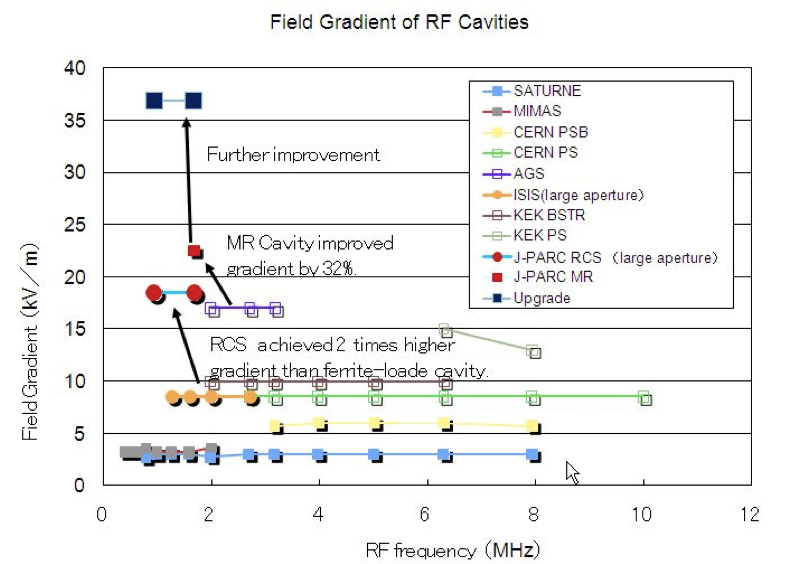
<Figure 7> Field gradient of RF cavities for proton synchrotrons. In case of rapid cycling machines, which need a large aperture for beam pipes, J-PARC RCS has achieved a two times larger field gradient than other machines (●). The MR cavities have also achieved the world-highest gradient in this frequency range (■). Further R&D to increase the gradient two times higher than the present J-PARC cavities are carried on (■)
International Collaboration
The RF systems using magnetic alloys have been used in many medical accelerators. Furthermore, they are also used for high energy experiments. For example, a very high energy and heavy ion colliding experiments is planned at LHC and acceleration of lead ions is necessary. To accelerate it, magnetic alloy-loaded cavities are used at LEIR(Low Energy Ion Ring)which is the first synchrotron in the accelerator chain. The accelerated beam from LEIR will be injected and accelerated at the PS (Proton Synchrotron) and the SPS (Super Proton Synchrotron), and then transported to the LHC.

<Figure 8> Magnetic alloy-loaded cavities and amplifiers at CERN-LEIR. These systems have achieved to generate the required RF voltage and 2nd Harmonic RF. They are used for a heavy-ion collider experiment at LHC.
[ Related Web Site ] J-PARC Home Page
http://www.j-parc.jp/index-e.html
- Auther : Accelerator Division Ⅰ, Chihiro Ohmori -



